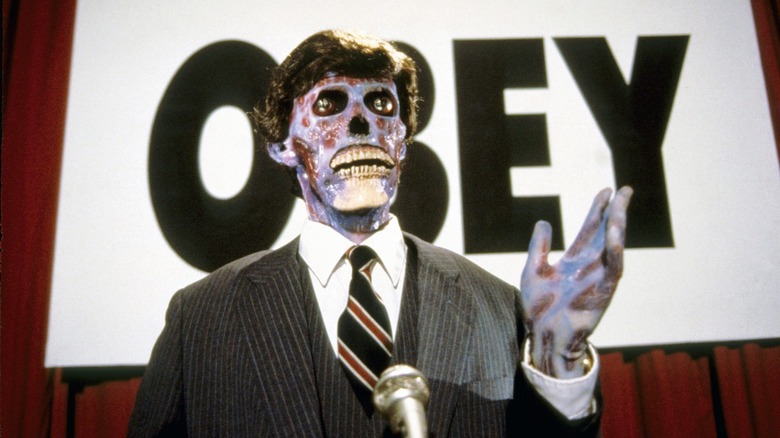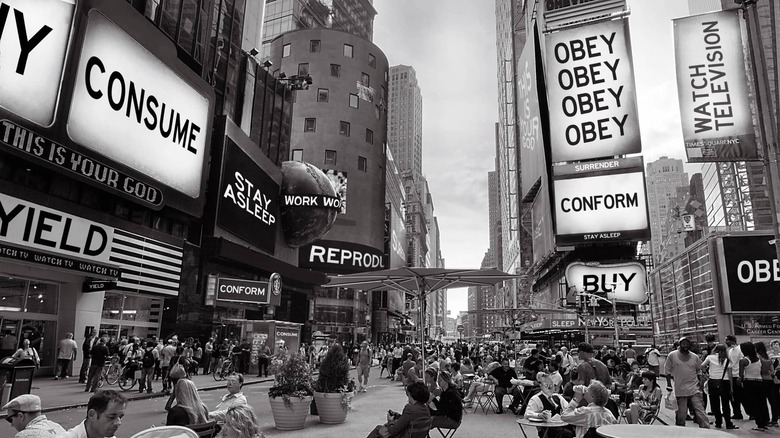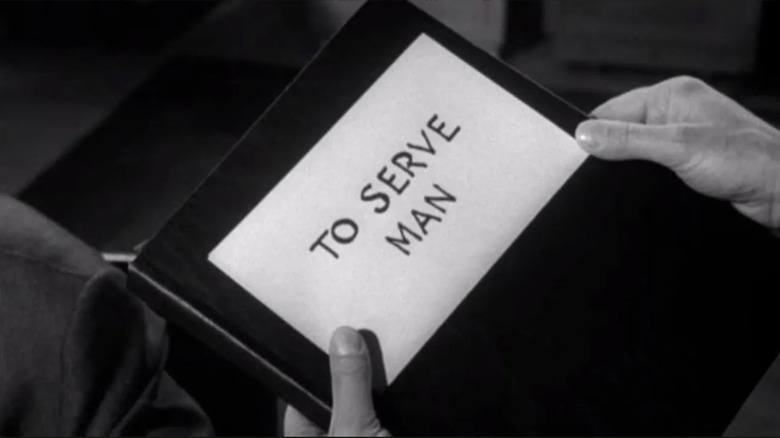John Carpenter's Inspiration For They Live Came Straight From The 1960s
"They Live" isn't John Carpenter's best movie, but it is his most socially-conscious. An anonymous drifter named Nada (Roddy Piper) discovers that aliens have invaded Earth. Worse, they've already conquered us because they've foregone the usual "flying saucers blast skyscrapers with lasers" route. No, these aliens walk among us, disguised as ordinary humans, while feeding us subliminal messages: "Buy." "Conform." "Obey."
The story is an allegory for how media and culture indoctrinate us so we spend our lives serving capitalism (in Marxist terms, how superstructure supports base). Piper's character is able to see the secret messages when he wears a pair of special sunglasses the aliens created. This too, is a metaphor, for having your eyes opened to the reality of the world.
Carpenter, a "no BS" director if there ever was one, told Starlog Magazine #136 (November 1988) what he was satirizing:
"The picture's premise is that the 'Reagan Revolution' is run by aliens from another galaxy. Free enterprisers from outer space have taken over the world, and are exploiting Earth as if it's a third world planet. As soon as they exhaust all our resources, they'll move on to another world... I began watching TV again. I quickly realized that everything we see is designed to sell us something."
In 2017, Carpenter reiterated this point while condemning those who've used his film in support of antisemitic conspiracy theories. However, the influences for "They Live!" don't end with the zeitgeist in which it was made.
Inspirations for They Live!
In 1963, a writer named Ray Nelson penned a short story for "The Magazine of Fantasy & Science Fiction." The story, "Eight O'Clock in the Morning," is about a man who, upon awakening from hypnosis, realizes that aliens called "Fascinators" walk among men. Only he is able to see the aliens' green-skinned true forms and their hidden messages of mass control. He has until 8:00 AM the next morning to expose them because after that, his heart will stop.
The 1980s saw that story adapted twice. First as the comic "Nada," by Nelson and artist Bill Wray, for a 1986 edition of the magazine "Alien Encounters." One of the people who read "Nada" was John Carpenter. Viewing it as a perfect vehicle to vent his frustrations with then-president Ronald Reagan and his administration, Carpenter was on the path to making "They Live."
The story was only about six pages long (and the comic eight pages), so Carpenter had to add a lot of detail to bring it up to 90 minutes. However, the film still hit the same beats: Nada is horrified by the messages and alien faces, is framed as a criminal, and infiltrates a TV station to disrupt the aliens' spell over humanity. In both prose and film, Nada sacrifices himself to reveal the truth: "George did not live to see the victory that finally came. He died of a heart attack at exactly eight o'clock."
The movie, on the other hand, ends with a cheeky touch from Carpenter: a woman discovers, mid-coitus, that her partner is one of the aliens.
Companion pieces
There's another, far more famous piece of 1960s science-fiction which sits alongside "They Live" — "The Twilight Zone." Carpenter's movie feels like a feature length episode; like many chapters of "The Twilight Zone" it's a B-Movie premise used for incisive commentary. Indeed, many "Twilight Zone" episodes were based on short stories, among them the classic alien invasion episode "To Serve Man." It's not hard to imagine a world where "Eight O'Clock in the Morning" was adapted by Rod Serling instead of John Carpenter.
"They Live" is not considered part of Carpenter's "Apocalypse" trilogy, which includes "The Thing," "Prince of Darkness," and "In the Mouth of Madness." However, it has the same themes of paranoia as "The Thing." The only difference? In "They Live" those themes are elevated to a macro, society-wide scale. Another alien invasion movie "They Live" has been compared to is "Invasion of the Body Snatchers." It's a sensible comparison, as both are about alien infiltration doubling as a political allegory. "Body Snatchers" has been remade so much because it's a flexible metaphor.
The original Don Siegel "Body Snatchers" picture, released in 1956, was about suburban conformity or, depending on who you ask, Red Scare hysteria a communist infiltrators. In 1978, Philip Kaufman reframed the story to be about post-Watergate alienation. Then in 1993, Abel Ferrara told yet another "Body Snatchers" about the military industrial complex seeping into American civilian life. The decade of Reaganomics didn't have a proper "Body Snatchers" movie, so Carpenter's film filled the void with "They Live."


